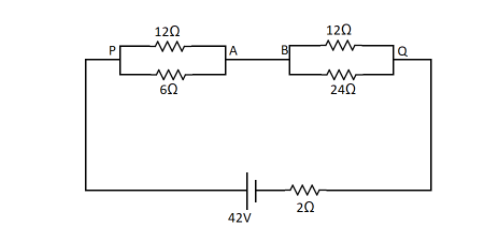Question
Question: Find the current in wire AB 
Solution
The wire AB in between connects all the 4 resistances. So by drawing the circuit in a simpler way, we can find the equivalent resistance. Then we can calculate the current being drawn from the cell using the emf of the call. This will be the current in the wire AB.
Formula Used In this solution, we are going to use the following formula,
Req=R1+R2+R3+.... where Req is the equivalent resistance when the resistances are placed in series.
And Req1=R11+R21+R31+.... where Req is the equivalent resistance when the resistances are placed in a parallel circuit.
V=IR where V is the emf of the cell, I is the current in the wires and R is the equivalent resistance.
Complete Step by Step Solution
To find the current in the wire AB we need to first redraw the circuit in a more simple way. Here the points A and B are the same point joined by a wire. So we can draw the circuit as,

From this circuit we can see that there are 2 parallel circuits consisting of 2 resistances each.
Let us first find the equivalent resistance between the points P and Q. The formula for parallel combination is
Req1=R11+R21+R31+....
Here we have R1=12Ω and R2=6Ω
So substituting we get,
Req11=121+61
Taking LCM as 12
Req11=121+2
So by taking the reciprocal we get,
Req1=312=4Ω
Similarly, between the points B and Q we have 2 resistances in parallel combination. So again here R1=12Ω and R2=24Ω
Substituting we get,
Req21=121+241
Taking LCM as 24,
Req21=242+1
Taking the reciprocal we get,
Req2=324=8Ω
Now the resistance Req1, Req2 and the internal resistance of the battery are in series in the circuit. So we use the formula for series combination given by,
Req=R1+R2+R3+....
Here R1=Req1=4Ω, R2=Req2=8Ω and R3=2Ω
So we get,
Req=4+8+2
Therefore, we get the equivalent resistance as,
Req=14Ω
Now it is given that the battery has an emf of V=42V
So from the Ohm’s law V=IR, we can get the current as,
I=ReqV
Substituting we get,
I=1442=3A
This is the whole current that is in the flowing through the wire. Now since between the points A and B the current doesn’t get divided, so the current in the wire AB will be 3A.
Note: In the given circuit, when the two resistances are in series condition then the current that flows in them both is the same whereas when the resistances are in parallel, the potential difference is the same across the resistances but the current varies. So the current in the 2 wires between P and A are different and depends on the magnitude of the resistance.
